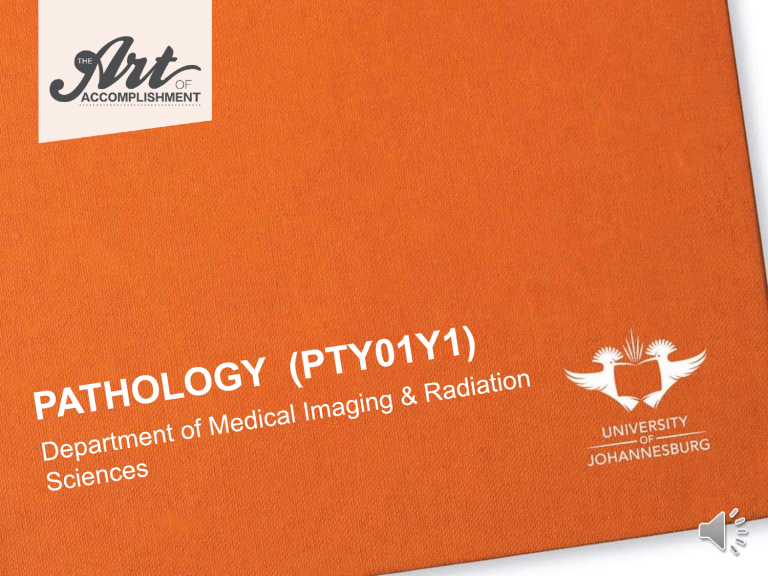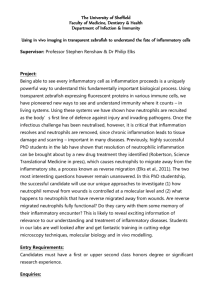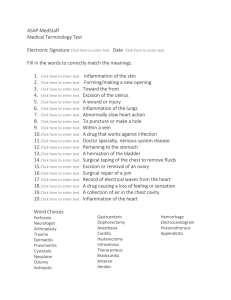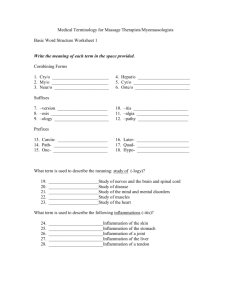
UNIT 4 : INFLAMMATION Outcomes • Describe the components and process of the inflammatory response. • Differentiate between acute and chronic inflammation. Please watch the video as this will help you understand the cells involved in the inflammatory process better as well as why the cardinal signs occur The Inflammatory Response https://www.youtube.com/watch?v=qCpWXPSMBIY AND Clinical features of inflammation https://www.youtube.com/watch?v=Kpx56iDvCdU Differentiate between Infection • Is present when pathogenic micro-organisms have established themselves in the tissues of some part(s) of the body and are able to survive and reproduce themselves therein Inflammation • Mechanism by which the body deals with an injury or insult • Process is characterized by release of inflammatory mediators and movement of fluid and leukocytes from the vasculature into the extravascular tissue Without inflammation, infections would go unchecked, wounds would not heal and injured tissues might remain permanent festering sores CAUSES OF INFLAMMATION • Infections (bacterial; viral ; fungal and parasitic) and microbial toxins – can range from mild to severe inflammation • Tissue necrosis due to ischaemia, trauma, physical and chemical injury (e.g. burns, frostbite, irradiation and environmental chemicals) • Foreign bodies(splinters, dirt, sutures) or endogenous substances( urate crystals ; cholesterol crystals) and lipids (obesity associated metabolic syndrome) • Immune reactions (allergies or auto-immune diseases) Cells of inflammation i.e endothelial cells; platelets, leukocytes • Endothelial cells - Lines the blood vessels and form capillaries - Separates intravascular and extravascular spaces - Produce agents that maintain vessel patency + vasodilators + vasoconstrictors - In the inflammatory process – provides a selective permeability barrier to exogenous and endogenous stimuli + regulates leukocyte extravasation(DIAPEDESIS) + regulation of immune responses + regulate immune cell proliferation - Part of repair process- produces growth factors • Platelets - Plays a role in homeostasis - Release inflammatory mediators that increase vascular permeability ; alters chemotactic, adhesive and proteolytic properties of endothelial cells - Over 300 proteins can be released when a platelet is activated Leukocytes Granulocytes Agranulocytes Neutrophils Monocytes Eosinophils Lymphocytes Basophils GRANULOCYTES Neutrophils Eosinophils Basophils/Mast cells Most numerous- first to appear at site of inflammation Accounts for 2-3%- appears much later than neutrophilsslow mobility Accounts for <1% Short life span Longer life span than neutrophils Contains a protein that is highly toxic to large parasitic worms that cannot be phagocytosed Scavenger cells – contains enzymes that degrade and engulf microbes and dead tissue Contain pathways for H2O2 and NO that aid in destruction of pathogens Important in allergic reactions and collagen diseases– releases chemical mediators Most prominent in allergic reactions- mediated by IgE Prevalent along the mucosal surfaces of the GIT tract; lung and dermis of the skin Rich in histamine(triggers inflammation) and heparin(anti-coagulant) Stimulate synthesis of cytokines and chemokines AGRANULOCYTES Monocytes (Macrophages) Lymphocytes Constitutes 3-8% of WBC – largest of circulating leukocytes Smallest of the leukocytes – predominant in lymphatic system than in blood Longer life span than granulocytes – assists in destroying causative agent, resolve inflammatory process, contributes to healing process NB in maintain chronic inflammation Linked to inflammatory conditions such as atherosclerosis Produces vasoconstrictive mediators; inflammatory cytokines and growth factors that promote regeneration of tissues Capable of phagocytosis and bacterial killing Participates in immune and non immune mediated inflammation caused by infectious agents Production of anti-bodies directed against persistent antigens The steps of the inflammatory process can be remembered by the cardinal signs and the 5 ”R’s” 5R’s = sequential steps of the inflammatory process:• RECOGNITION - Offending agent in extravascular tissues is recognized by host cells and molecules • RECRUITMENT- Leukocytes and plasma proteins located to area of offending agent • REMOVAL- Leukocytes and proteins activated to destroy and eliminate offending agent • REGULATION- Reaction is controlled and terminated • REPAIR- The damaged tissue is repaired Unit 4 Task 3 FOR DISCUSSION IN THE NEXT LECTURE PERIOD!!!!!!! 1. Differentiate between ACUTE and CHRONIC inflammation 2. Briefly discuss the stages of acute inflammation….. REFER TO THE PRESCRIBED TEXTBOOK!!!!!! 3. Differentiate between a transudate and an exudate and state the functions of an exudate 4. Discuss the manifestations/sequelae of acute inflammation REFERENCES • Porth, C.M. (2015). Essentials of Pathophysiology. 4th Ed. Wolters Kluwer. • Kumar,R., Abbas, A. & Aster,E. (2015): Pathologic Basis of Disease. 9th Ed., Elsevier • Loveday, J. (1994): Davies’ Medical Terminology: A guide to current usage. 5th Ed., Butterworth Heineman, Oxford





